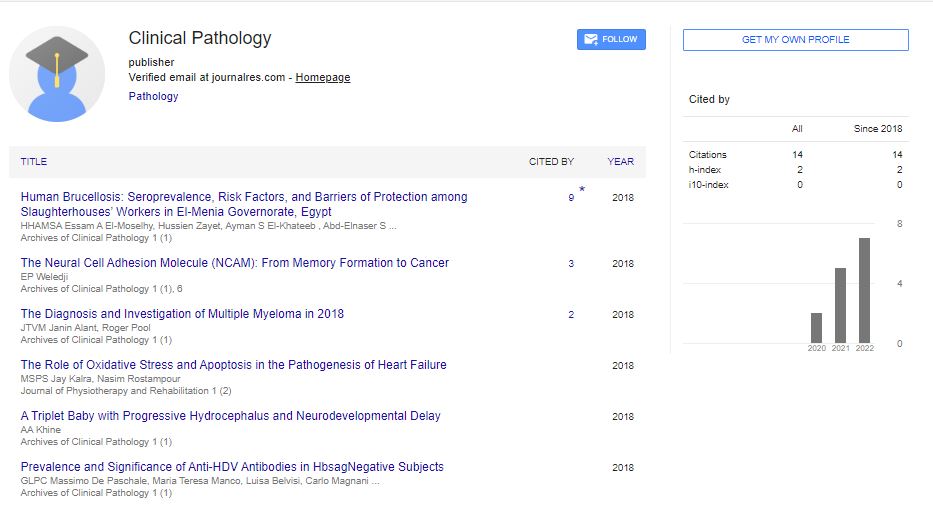Short Communication, Arch Clin Pathol Vol: 6 Issue: 1
Viral Pathogenesis and Host-Pathogen Interactions
Zhen Chao*
Department of Microbiology, Henan University, Henan, China
*Corresponding Author: Zhen Chao
Department of Microbiology, Henan University, Henan, China
E-mail: zhenchao@hunan.cn
Received date: 20 February, 2023, Manuscript No. ACPY-23-93152;
Editor assigned date: 22 February, 2023, PreQC No. ACPY-23-93152 (PQ);
Reviewed date: 09 March, 2023, QC No. ACPY-23-93152;
Revised date: 16 March, 2023, Manuscript No. ACPY-23-93152 (R);
Published date: 23 March, 2023, DOI: 2324-8955/acpy.05.03.100075
Citation: Chao Z (2023) Viral Pathogenesis and Host-Pathogen Interactions. Arch Clin Pathol 6:1.
Description
Viruses are obligate intracellular parasites that rely on the host cell machinery for their replication and survival [1]. They can infect a wide range of hosts, including humans, animals, and plants, and cause a variety of diseases. Viral pathogenesis refers to the mechanisms by which viruses cause disease, while host-pathogen interactions refer to the complex interplay between the virus and the host's immune system. Understanding these processes is important for the development of effective antiviral therapies and vaccines. Viral pathogenesis is a complex process that involves a series of events, including viral entry, replication, spread, and the immune response. The first step in viral pathogenesis is viral entry, which occurs when the virus gains access to the host cell. This can occur through a variety of mechanisms, including receptor-mediated endocytosis, direct fusion with the cell membrane, or the use of specialized cell-penetrating proteins. Viruses enter host cells through a variety of mechanisms, including receptor-mediated endocytosis, fusion, and direct penetration [2,3]. Once inside the cell, the virus uses the host cell's machinery to replicate and produce new virus particles. Viral replication can lead to cell death, tissue damage, and the release of new virus particles. The type and severity of tissue damage depend on the specific virus and the host's immune response. The host's immune response plays a critical role in viral pathogenesis [4]. The immune system can either limit viral replication and prevent tissue damage or contribute to tissue damage through excessive inflammation and cytokine release. Once the virus has entered the host cell, it begins to replicate, using the host cell's machinery to produce new viral particles. Viral replication can lead to cell death, either through direct lysis of the infected cell or through the induction of apoptosis. Cell death can result in tissue damage and inflammation, which can contribute to the symptoms of a viral infection. As the virus continues to replicate, it can spread to other cells and tissues in the body [5,6]. This can occur through direct cell-to-cell transmission, the bloodstream, or the lymphatic system. The spread of the virus can lead to systemic infection, which can have severe consequences, particularly if the virus infects vital organs [7]. The host immune system plays a major role in controlling viral infections. Upon infection, the host immune system is activated, triggering a complex series of events that are designed to eliminate the virus [8,9]. These events include the activation of immune cells, such as T cells and B cells, the production of cytokines and chemokines, and the induction of an antiviral state in infected cells [10]. However, viruses have evolved a variety of mechanisms to evade or subvert the host immune response. These mechanisms include the production of viral proteins that inhibit immune cell function, the suppression of cytokine production, and the expression of viral proteins that mimic host proteins to evade detection [11]. The interplay between the virus and the host immune system can determine the outcome of viral infection. In some cases, the immune response is effective at controlling the infection, leading to viral clearance and recovery. In other cases, the virus is able to evade or subvert the immune response, leading to chronic infection and disease.
Conclusion
Viral pathogenesis and host-pathogen interactions are complex processes that involve a range of mechanisms, from viral entry and replication to immune activation and evasion. Understanding these processes is essential for the development of effective antiviral therapies and vaccines. Advances and understanding of viral pathogenesis and host-pathogen interactions have already led to the development of highly effective antiviral therapies for some viral infections, like HIV and hepatitis C, have the potential to lead to the future development of cures for other viral infections.
References
- Enkirch T, Von Messling V (2015) Ferret models of viral pathogenesis. Virol J 479:259-70.
[Google Scholar] [PubMed]
- Ellis JA (2009) Update on viral pathogenesis in BRD. Anim Health Res Rev 10(2):149-53.
[Google Scholar] [PubMed]
- Gottwein E, Cullen BR (2008) Viral and cellular microRNAs as determinants of viral pathogenesis and immunity. Cell host & microbe 3(6):375-87.
[Google Scholar] [PubMed]
- Akaike T (2001) Role of free radicals in viral pathogenesis and mutation. Rev Med Virol 11(2):87-101.
[Google Scholar] [PubMed]
- Schoggins JW (2014) Interferon-stimulated genes: roles in viral pathogenesis. Curr Opin Virol 6:40-6.
[Google Scholar] [PubMed]
- Fensterl V, Sen GC (2015) Interferon-induced fit proteins: their role in viral pathogenesis. J Virol 89(5):2462-8.
[Google Scholar] [PubMed]
- Martina BE, Koraka P, Osterhaus AD (2009) Dengue virus pathogenesis: an integrated view. Clin Microbiol Rev 22(4):564-81.
[Google Scholar] [PubMed]
- Van der Poll T, Opal SM (2008) Host–pathogen interactions in sepsis. Lancet Infect Dis 8(1):32-43.
- Casadevall A, Pirofski LA (1999) Host-pathogen interactions: redefining the basic concepts of virulence and pathogenicity. Infect Immun 67(8):3703-13.
- Doherty CP (2007) Host-pathogen interactions: the role of iron. J Nutr 137(5):1341-4. [Google Scholar]
[PubMed]
- Casadevall A, Pirofski LA (2000) Host-pathogen interactions: basic concepts of microbial commensalism, colonization, infection, and disease. Infect Immun 68(12):6511-8.
[Google Scholar] [PubMed]
